- About MAA
- Membership
- MAA Publications
- Periodicals
- Blogs
- MAA Book Series
- MAA Press (an imprint of the AMS)
- MAA Notes
- MAA Reviews
- Mathematical Communication
- Information for Libraries
- Author Resources
- Advertise with MAA
- Meetings
- Competitions
- Programs
- Communities
- MAA Sections
- SIGMAA
- MAA Connect
- Students
- MAA Awards
- Awards Booklets
- Writing Awards
- Teaching Awards
- Service Awards
- Research Awards
- Lecture Awards
- Putnam Competition Individual and Team Winners
- D. E. Shaw Group AMC 8 Awards & Certificates
- Maryam Mirzakhani AMC 10 A Awards & Certificates
- Two Sigma AMC 10 B Awards & Certificates
- Jane Street AMC 12 A Awards & Certificates
- Akamai AMC 12 B Awards & Certificates
- High School Teachers
- News
You are here
Mathematical Mysteries of Rapa Nui with Classroom Activities: Background on the Hare Paenga (Boat Houses)
Before analyzing the next two mysteries, some background knowledge will be helpful. Archaeological objects called paenga can be found throughout Rapa Nui. These basalt curbstones once formed foundations of thatched houses called hare paenga or “boat houses”, which were so named since they looked like overturned boats. Holes in the paenga stones held poles that were tied together and then covered with thatch. A low door would be in the center of one of the longer sides of the boat house, which opened out to a stone patio. People slept “parallel to the long axis of the house, the head being towards the door; the old people were in the centre in couples, and the younger ones in the ends” [Routledge 1920, 200].
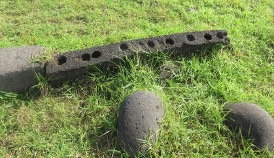
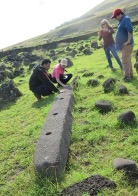
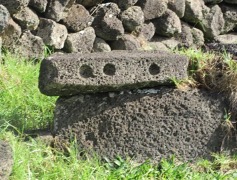
Figure 8. Three views of dressed paenga stones.
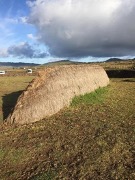

Figure 9. Exterior and interior of replica hare paenga; (Right) the inside shows the poles and thatching as well as Catepillán’s son, Sebastian.
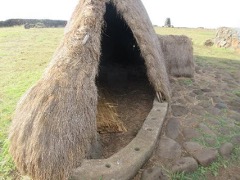

Figure 10. (Left) Cutaway view of replica hare paenga revealing the foundation. (Right) Ximena Catepillán exiting a replica hare paenga.
The dressed paenga stones were reused throughout the years. Sometimes new holes were made and the stones were reused for another hare paenga. Others were reused in construction projects such as ahu platforms for moai, terraces, and well linings. Paenga were even “seized upon as booty in enemy raids” [Routledge 1920, 199]. More recently, during the first half of the 20th century, when most of the island was used for sheep farming, the stones were used in the stone walls that were constructed throughout the island.

Figure 11. Curbstones (paenga) reused to form an earth oven.
Ximena Catepillán (Millersville University), Cynthia Huffman (Pittsburg State University) and Scott Thuong (Pittsburg State University) , "Mathematical Mysteries of Rapa Nui with Classroom Activities: Background on the Hare Paenga (Boat Houses)," Convergence (March 2021)




